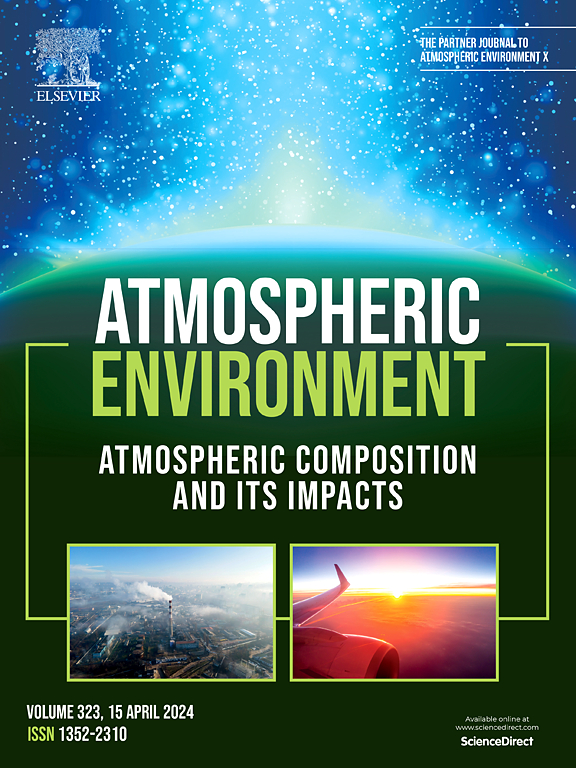Sub-micron aerosol and CCN characteristics in Seoul measured during 2019–2021 and CCN prediction using machine learning
IF 3.7
2区 环境科学与生态学
Q2 ENVIRONMENTAL SCIENCES
引用次数: 0
Abstract
The seasonal characteristics of aerosol number concentration (NCN) and cloud condensation nuclei number concentration (NCCN) in Seoul from 2019 to 2021 were analyzed. The average NCN and NCCN at 0.6 % supersaturation (SS) were 12,612 cm−3 and 2,829 cm−3, respectively, representing significant decreases of approximately 30 % and 50 % compared to the values from 2004 to 2010. Despite these reductions, diurnal and seasonal patterns remained consistent over time. However, distinct seasonal differences were noted, particularly in the relationship between NCN and NCCN: in winter, NCN and NCCN exhibited similar trends in both diurnal variation and back trajectory analysis, whereas in summer, their trends frequently diverged. To account for these pronounced seasonal differences, predictions of NCN and NCCN were conducted separately by season using the Random Forest Regression Model. The seasonally tailored predictions provided improved performance compared to the Multiple Linear Regression Model used as a baseline. Analysis of importance of each predictor revealed that NCN was the most significant predictor of NCCN at 0.4–1.0 % SS in winter, while particulate matter (PM10) played a more critical role across all supersaturation levels in summer and at 0.2 % SS in winter. These results suggest seasonally distinct mechanisms driving CCN formation in Seoul. Overall, this study highlighted recent trends in aerosols and CCN reflecting the rapid changes of air quality at a representative urban region in East Asia, and the data presented in this study can be used as representative values of aerosol and CCN in East Asian urban region for aerosol–cloud interaction studies in climate models.
2019-2021年期间测量的首尔亚微米气溶胶和CCN特征以及使用机器学习的CCN预测
分析了2019 - 2021年首尔地区气溶胶数浓度(NCN)和云凝结核数浓度(NCCN)的季节特征。0.6%过饱和度(SS)下的平均NCN和NCCN分别为12,612 cm - 3和2,829 cm - 3,与2004 - 2010年的值相比,分别显著下降了约30%和50%。尽管有这些减少,但随着时间的推移,日和季节模式保持一致。NCN与NCCN之间存在明显的季节差异,冬季NCN与NCCN在日变化和反轨迹分析上均表现出相似的趋势,而夏季NCN与NCCN的变化趋势则经常出现背离。为了解释这些明显的季节差异,使用随机森林回归模型分别对NCN和NCCN进行了季节预测。与作为基线的多元线性回归模型相比,季节性定制的预测提供了更好的性能。各预测因子的重要性分析表明,NCN在冬季0.4 ~ 1.0% SS时是NCCN的最显著预测因子,而颗粒物(PM10)在夏季和冬季0.2% SS时在所有过饱和水平中起着更为关键的作用。这些结果表明,驱动首尔CCN形成的季节性机制不同。总的来说,本研究突出了反映东亚代表性城市地区空气质量快速变化的气溶胶和CCN的最新趋势,本研究提供的数据可以作为东亚城市地区气溶胶和CCN的代表值,用于气候模式中气溶胶-云相互作用研究。
本文章由计算机程序翻译,如有差异,请以英文原文为准。
求助全文
约1分钟内获得全文
求助全文
来源期刊

Atmospheric Environment
环境科学-环境科学
CiteScore
9.40
自引率
8.00%
发文量
458
审稿时长
53 days
期刊介绍:
Atmospheric Environment has an open access mirror journal Atmospheric Environment: X, sharing the same aims and scope, editorial team, submission system and rigorous peer review.
Atmospheric Environment is the international journal for scientists in different disciplines related to atmospheric composition and its impacts. The journal publishes scientific articles with atmospheric relevance of emissions and depositions of gaseous and particulate compounds, chemical processes and physical effects in the atmosphere, as well as impacts of the changing atmospheric composition on human health, air quality, climate change, and ecosystems.
 求助内容:
求助内容: 应助结果提醒方式:
应助结果提醒方式:


